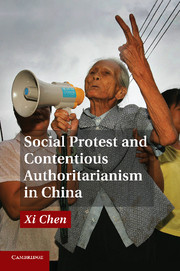Book contents
- Frontmatter
- Contents
- Figures and Tables
- Acknowledgments
- Part I A Contentious Society
- Part II Political Opportunity Structure
- 3 Market Reforms and State Strategies
- 4 The Xinfang System and Political Opportunity
- Part III Protest Strategies and Tactics
- Part IV Conclusion
- Appendix
- Bibliography
- Index
- References
3 - Market Reforms and State Strategies
Published online by Cambridge University Press: 05 December 2011
- Frontmatter
- Contents
- Figures and Tables
- Acknowledgments
- Part I A Contentious Society
- Part II Political Opportunity Structure
- 3 Market Reforms and State Strategies
- 4 The Xinfang System and Political Opportunity
- Part III Protest Strategies and Tactics
- Part IV Conclusion
- Appendix
- Bibliography
- Index
- References
Summary
How do we account for the upsurge of collective protest in China since the early 1990s? It is impossible to understand this trend without analyzing the changing political structure surrounding claim making, especially the way in which state agents cope with claim-making activities. Patterns of state strategies – for example, the state’s propensity and capacity for repression – have long been regarded as a key aspect of the political opportunity structure that influences popular contention. In the Reform Era, the Chinese state has developed a particular repertoire of strategies for coping with popular contention: generally restrained repression with a goal of containment rather than deterrence, expedient concessions, practical persuasion, and prevalent procrastination. Such a pattern of state strategies make collective petitioning with “troublemaking” tactics a rational and even attractive choice: Such forms of social protests are not overly risky, often somewhat effective, and usually indispensable for their success.
Of course, this pattern of state strategies is itself a product of economic reforms and the sociopolitical transformations they have triggered. Thus this chapter will examine how two important processes in the Reform Era – the changes in state-society linkages and those in the state structure – have transformed the strategic repertoire that state agents use when responding to social protest.
- Type
- Chapter
- Information
- Social Protest and Contentious Authoritarianism in China , pp. 59 - 86Publisher: Cambridge University PressPrint publication year: 2011
References
- 1
- Cited by

